As the river leaves MP (with Alirajpur on the northern banks and Maharashtra on the south, it enters Gujarat on the northern side, thus, forming a three-state boundary. On Gujarat side the first district is Chhota Udaipur while the southern side remains Nandurbar in Maharashtra for a distance of 40 km. The backwaters of Sardar Sarovar dam are prominent in this region and it is therefore not possible for Parikramavasis to walk along the banks. They have to take village roads that take them longer than what was the case before.
After this common zone between Gujarat and Maharashtra, the river soon flows completely in Gujarat.
The demography so far as the significant presence of tribal communities is concerned, continues even as the Narmada careers out of the state of her origin. Nandurbar district in Maharashtra has 70 percent tribal population.
The case is not too different in the four districts Narmada passes through in Gujarat. In the district of Chhota Udaipur (carved out in 2013 out of Vadodara district) the tribal communities form nearly 79 percent of the population. In the district ‘Narmada’ (carved out of areas of Vadodara and Bharuch districts) the tribal people form 81 percent of the population. Even in the more urbanised districts of Bharuch and Vadodara the tribal communities form 32 percent and 27 percent of the population respectively.
Narmada is almost inseparable with the tribal communities in the same way as is difficult to imagine her without the Vindhyachal and Satpura ranges. Other than in the central plains of its trajectory in MP where non-tribal communities have been engaged in reasonably profitable agriculture, the Narmada belt is dominated by a very significant presence of tribal communities. The tribes have been limited to the hills and forests, and other stony and infertile lands like in western MP where gainful practice of agriculture has really not been viable. As we saw in the earlier sections of the series in some areas they had been pushed to the hills by more powerful forces and later their practices of shifting agriculture also got disturbed and discontinued.
Chhota Udaipur area was formerly ruled by the Bhils till late 15th century. Much later, in the eighteenth century, it became a more formal princely kingdom under Rawal Udai Singh – ‘Rawal’ meaning ‘Raja.’ Indeed the city of Rawalpindi (the twin city of Pakistan’s national capital of Islamabad) has this term as its etymological origin. It maintained its status as a princely state till its ascension in 1948 into the Union of India. .
The Chhota Udaipur area has the dominant tribe of the Rathwas who are considered as a part of the larger Bhil group and are said to have migrated from Alirajpur area of present-day Madhya Pradesh around 600 years back. This migration had also happened to present-day districts of Vadodara and Panchmahal. The last Rathwa ruler Kantia Bhil was killed in 1474. However there are scholars who forward the idea that Rathwas are different from Bhils and cannot be lumped in that group.
The town of Naswadi in the Chhota Udaipur district is the closest place on the northern banks of Narmada from where one goes to the famed Sardar Sarovar and the world’s tallest statue ‘Statue of Unity’ which though comes in the district ‘Narmada.’ Naswadi itself was a princely state ruled by the Rajput clan of the Solankis and was a vassal state of the larger Baroda state of the Gaekwads.
After the district of Chhota Udaipur next in the trajectory is the district of Narmada (with district headquarters at the town of Rajpipla.)
The area around ‘The Statue of Unity’ is now called the ‘Ekta Nagar’ and has become a prominent tourist hub and a plethora of expensive hotels and departmental stores and eateries like the MacDonalds. The Statue project, however, was not completed without witnessing the opposition of activists and representatives of local tribal communities. Safaris into the adjoining Satpura hills, which form the Shoolpaneshwar Reserve spread over about 600 sq ft, on the south and east, also offered as part of the tourist packages.
While this might have ushered in economic opportunities in the area, this touristy is markedly different from the traditional pilgrim-touring in the Narmada region where one could travel with the most meagre resources – indeed without any money at all as in the case of the Parikramavasis. The villages closest to the location where the am has been constructed are Navagam on the northern banks and Gora on the other. A little west of Navagam is the village of Kevadiya.
This dam has significantly changed not just the geography but the demography too, with many MP tribesmen who lost their villages submerged in the backwaters getting rehabilitated in Gujarat. The assessment of merits of the dam or its drawbacks remains a highly contested issue even now. It is too complex to be given any space in this writing and the present writer makes no claims to possess any nuanced understanding of this subject.
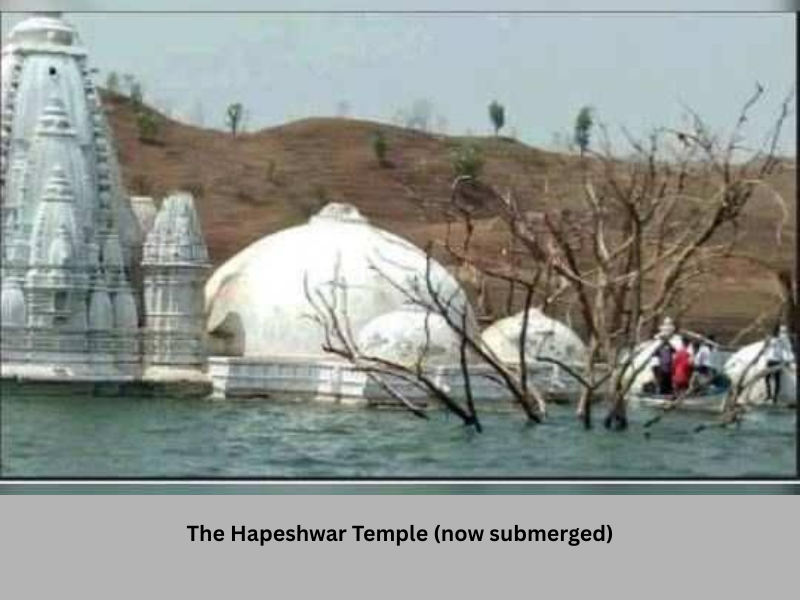
The power generated is shared between the three states of MP, Gujarat and Maharashtra from where tributaries merged with Narmada and villages were submerged. The water from the Sardar Sarovar Dam is sent to far-off areas like districts of Jaisalmer and Barmer in Rajasthan, much of Gujarat -particularly the rain-starved northern part of Kutchh, and Maharashtra. Though Rajasthan had no tributary merging into Narmada nor any area submerged due to the dam, the three states of MP, Gujarat, and Maharashtra decided to give about 5 percent of water to Rajasthan, viewing it as a matter of national interest.
Coming back to the theme of important pilgrim places, the first major one in Gujarat is Hapeshwar on the northern banks in Chhota Udaipur district. The Hapeshwar temple has got submerged in the dam but its ‘Shikhar’ gets visible at times. Due to lower water levels in 2018 a large part of it became visible after more than a decade. The name ‘Hapeshwar’ according to eminent scholar-saint Shastriji Maharaj of Nemawar, was ‘Aapeshwar’ meaning ‘God of water’ – ‘Aap’ meaning water in Sanskrit. As the name suggests the place is related to Varuna, the Lord of water.
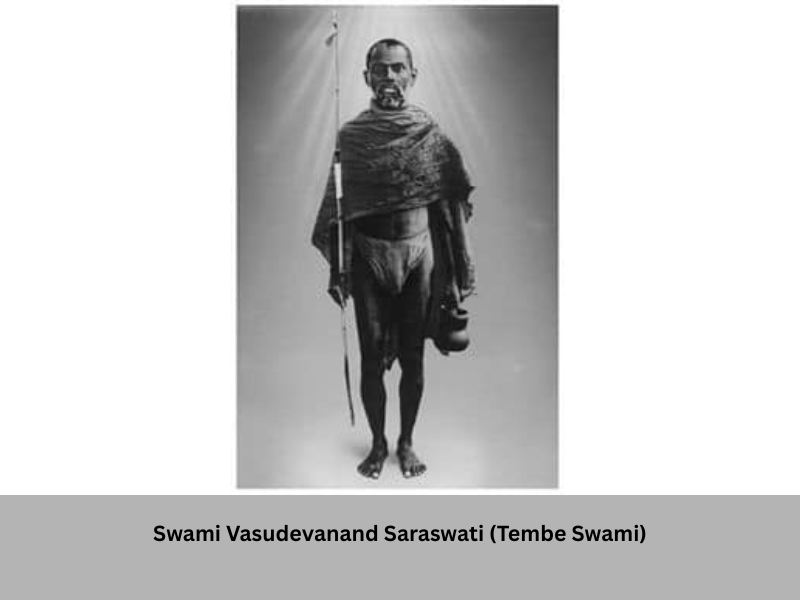
Further downstream on the northern banks is located Garudeshwar (where Garuda is said to have done Tapasya for Shiva). It is very near to Naswadi and ‘The Statue of Unity’ and comes in ‘Narmada’ district. It also has a Datta Mandir and place of Samadhi of the great saint of Narmadakhand Swami Vasudevananda Saraswati, also known as Tembe Swami. His presence led to Garudeshwar becoming one of the foremost Teerthas in the Narmadakhand. He popularised the glory of Narmada and Narmada Parikrama far and wide. Countless persons in subsequent generations have been inspired towards Narmada Parikrama owing to him.
This extraordinary ascetic was born in 1854. He travelled all across the country as a Parivrajak (wandering monk) for 23 years before coming to Garudeshwar which was a forested area at that time. He was a devotee of Lord Dattatreya. He had many disciples who were great spiritual teachers themselves. Sri Vasudev Saraswati was a great scholar in Sanskrit wrote a number of books in that language. He had a great gift for composing verse in Sanskrit. Some of his most celebrated books are Dwisahasri Gurucharit, Datta Puran, Datta Mahatmya and Saptashati Gurucharitra Saar. He laid down his body in 1914 after predicting the date of his departure. He sat in meditative posture and chanting Om left his body.
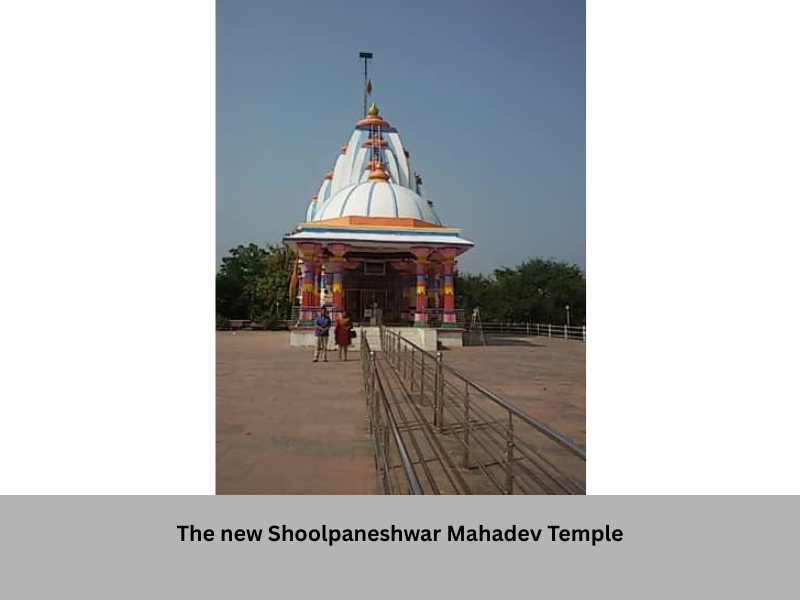
There is a highway bridge just downstream of Garudeshwar at a place called Akteshwar. The newly built Shoolpaneswar Mahadev (the original being submerged in the dam backwaters) is also near Garudeshwar but on the opposite (southern banks) near the village of Gora, very close to the Statue of Unity.
About ten miles from Garudeshwar is the town of Tilakwada which too has temples and ashrams though it is a few miles removed from Narmada. Swami Atmakrishna who has done Parikrama a few times and has authored valuable handbooks for Parikramavasis, particularly incorporating the changes in routes after the coming up of several dams, has his base here.
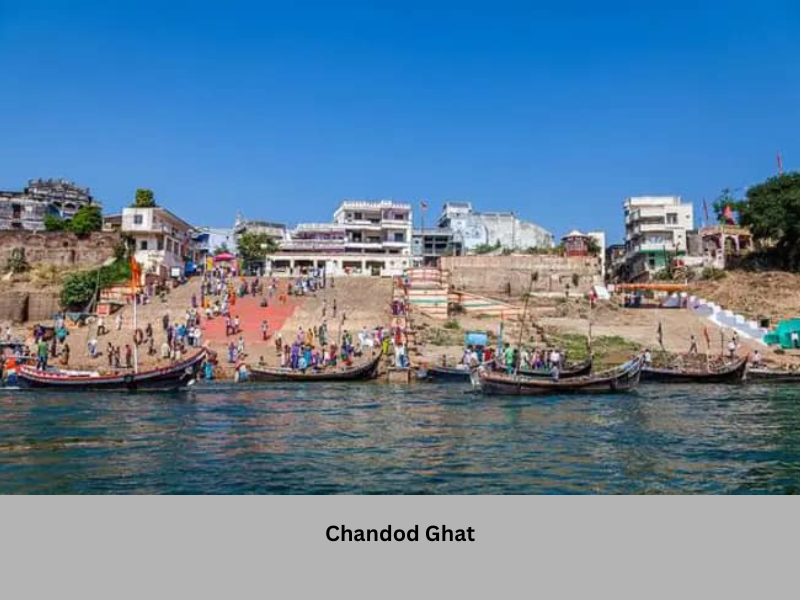
On the southern banks, quite close to each other are Rameshwar, Lakshmaneshwar and Hanumanteshwar.
The next district on the northern banks of the trajectory is Vadodara (Baroda) while the district of Narmada continues on the south of the river. Though the city of Baroda is about 50 km north of the river the district has very important places like Chandod and Karnali (a few miles away) which is known as Dakshin Prayag and has a Triveni Sangam of Narmada, Orsang and Saraswati). The Orsang river originates from Madhya Pradesh and flowing through Chhota Udaipur and Vadodara it meets Narmada here. The Chanod-Karnali area carries high importance with regard to conducting the ‘Shraddha’ rites. There are a number of temples and ashramas in the area.
Immediately after Chandod on the same side comes Gangnath. It is said that the great river Ganga herself comes to take a holy bath in Narmada once a year at this place. It is considered to be a great Teertha.
In this area, lived the great Yogi Swami Brahmananda, who was said to have seen many a century in his lifetime. Sri Aurobindo (then serving in the Baroda state ruled by the highly progressive Sayaji Rao Gayekwad) often visited him. The latter had so much fascination for the area that he had conceived his ‘Bhavani Mandir’ scheme for which he wrote a pamphlet (an ashrama where all-renouncing patriots will live and work towards freeing their country – the impress of Bankimchandra’s Anandamath is unmistakable both in the idea of renunciate-patriots as well as viewing the nation as Devi (the Mother Goddess.) The project in its full scope, however, did not take off, though a school training patriots, away from the eyes of the colonial masters, is said to have been run there for some time.
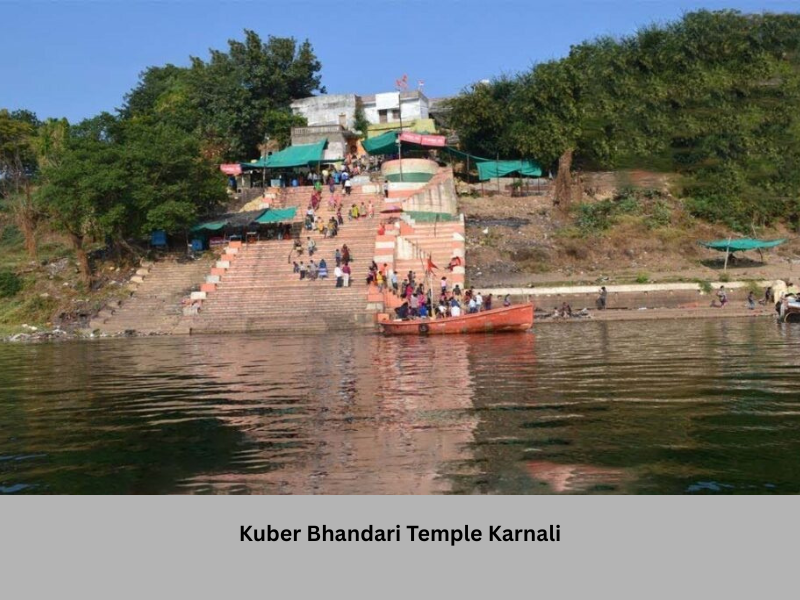
At Chandod also lived another renowned Yogi, Sri Balananda Brahmachari, who later founded an ashrama in Deoghar in Jharkhand, with considerable following in that part of the country, and Bengal in particular with his tradition continued by his disciple Sri Mohananda Brahmachari.
Further downstream, about ten miles or so, one finds a big riverine island called the Vyasbet. Just in front of Vyasbet is the Shukdev Teertha on the southern banks. Incidentally, Vyas was the father of Shukdev.
The town of Sinor is located on the northern banks. It is the birthplace of eminent Gujarati literary figure Ramakant Vasantlal Desai who had by his voluminous corpus of work, in the first half of the twentieth century, form of novels, short stories and poems enriched the literature in that language in a significant way. Sinor is just a couple of miles from a very important place of Malsar. It has a number of temples and ashramas, among them being that of renowned saint Sri Madhavdasji. Also Malsar is know for its association with Sri Ramachandra Keshav Dongre ji Maharaj, who was nationally famous as a Katha-Vachak of Srimad Bhagwatam. A householder, he used to donate all the proceeds of each of his ‘Katha’ to some humanitarian or social cause. There have been several Annakshetras in the Narmadakhand started by Dongre ji Maharaj. It is said that when the wife of this great man who had donated millions of rupees passed away he did not even have ready cash to do her last rites. Such was the austerity he practised even while being amidst so much following. Anyone who has listened to Sri Dongre ji Maharaj vouches for the deep undeniable feeling that whole ambience stood transfigured by his presence and all among the audience, even small children, listened to him with rapt attention, as if under a spell. Sri Dongre ji Maharaj had his final resting place at Malsar on banks.
▶Next Chapter: Towards the Sea